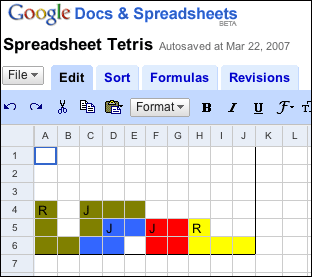The joy of spreadsheets
I’m really liking Google Spreadsheets.
Fact is, I’ve never had much use for spreadsheets, which is why I’m hopelessly lost in pivot tables and anything more complex than a sum formula. (My wife, by way of contrast, can make a spreadsheet compile to solve prove Fermat’s Theorem, I am quite sure.) Still, I have always loved spreadsheets’ boxy structure. I keep lots of data in spreadsheets, but it doesn’t do anything. Just sits there. Tabularly.
But a shared online spreadsheet is a different beast altogether. I have a variety of home-related data in gSpread (sounds dirty, no?) so my wife and I can reference the same stuff. Two co-workers of mine and I keep track of daily You Don’t Know Jack scores in a shared sheet. (By year’s end — assuming Google adds charts to the tool — the YDKJ score log should be an interesting set of data to mine.)
This weekend my college pals and I conducted our annual fantasy baseball draft. It is an excuse to get together in person for much hazing and idiocy, but this year gSpread made it much more efficient. Most of us had laptops open with a Excel sheet imported into Google. One person updated the main player list, another the By Pick list, and another the By Team list. We all saw everything instantly, editing the same tables simultaneously. As did a friend at home who could not make it to Chicago. A perfect use for shared data.

But the best use by far is what I call two-player, slow-motion Tetris. Actually it is a kind of a merger of Tetris and checkers or Connect Four. Each player (or collaborator in gSpread parlance) clicks on cell that randomly selects a piece (=randbetween(1,7)) then places that piece in whatever rotation desired. The goal is to clear a line as in normal Tetris but also to block someone else from doing so. Letters in the pieces let players know which pieces are theirs — useful since the game takes weeks to play out. Fun, but dorky. No, fun because dorky. Who’s in?













